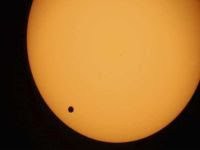Venus passes in front of the Sun on Tuesday
The phenomenon, which will only be repeated in 2117, will be observed as a dot on the sun on the 5th and 6th of June...
The last passage of Venus between the Earth and the Sun was in 2004 and the next will only be in 2117. A dot will be seen moving slowly over the sun, in a rare transit of Venus, when the planet passes between Earth and the Sun. An event so rare that the next will only be observed in 2117.
It is an event so unique that schools and museums around the world are preparing celebrations to accompany the phenomenon and the astronauts aboard the International Space Station are also planning to observe the event.
The transit begins on Tuesday (June 5, at 18h09 in GMT) west of the Greenwich Meridian, and Wednesday (6th), east of it. It will last six hours and 40 minutes and will be visible in the western Pacific to eastern Asia and eastern Australia.
Observers in Canada, the United States, Mexico, Central America and northern South America can see the beginning of the show before the sun sets. Europe, western Asia and central West Africa and eastern Australia will catch the end, after sunrise. NASA is planning to provide live webcasts.
"Any silhouette in the Sun is interesting. To view Venus is extremely rare," said astronomer Anthony Cook of the Griffith Observatory.
There were 53 Venus transits between 2000 and 2004 BC. "As soon as a transit occurs, another follows it in just eight years, less two days, but then it takes 105 years until it happens in another pair of transits separated by eight years," said Bob Berman, a columnist for the magazine, Astronomy.
Past and future
In the past, the transit of Venus was spotted by astronomers such as Galileo Galilei and James Cook. Scientists of the 6th and 7th centuries observed the transits of Mercury and Venus, the two planets' interiors, "to measure the distance from Earth to the Sun in an effort to calculate the size of our Solar System. The explorer, James Cook, observed a transit of Venus in Tahiti in the 18th century.
However, although "we have already calculated their number, transits are still useful," said Frank Hill, Solar Observatory of the USA (NSO), in a statement.
The last transit of Venus this century "will help us to calibrate different instruments. It will also help with the hunt for extrasolar planets with atmospheres, and to learn how to evaluate other solar systems in our search for life in the universe."
The NSO will use their telescopes in Arizona, New Mexico, California, Hawaii, Australia and India to record this moment with hundreds of images that will be displayed in real time on their website.
The NSO telescopes will attempt to obtain additional measurements of the structure of the atmosphere of Venus seeking spectral traces produced by carbon dioxide emissions, which are abundant in the atmosphere of Venus.
With a large gathering on Mauna Kea (Hawaii), considered the best place on the planet to see the phenomenon, NASA will broadcast the event live on their site and analysts will connect with their centers as well. Around the world, 148 countries will conduct monitoring activities.
A reminder is also appropriate that the same warning be made about looking at this special activity without special lenses and precautions. Looking at the Sun without protection will cause eye damage.
Translated from the Portuguese version by:
Lisa Karpova
Pravda.Ru

Subscribe to Pravda.Ru Telegram channel, Facebook, RSS!


